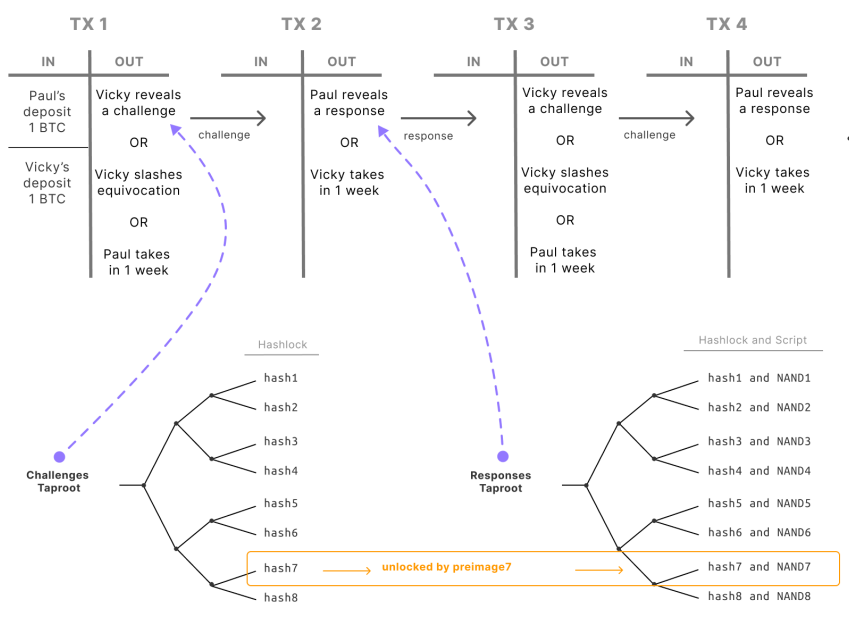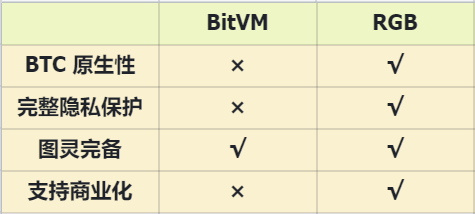Author: Echo, Infinitas
Director: Hong Shuning
On October 9, Robin Linus, co-founder of blockchain developer ZeroSync announcedBitVM white paper. “Any computable function can be verified on Bitcoin” Linus on X (formerly Twitter)Post said.“This makes smart contracts on Bitcoin more expressive. In particular, it enables functionality that we believe would require a soft fork” — potentially bringing more DeFi use cases and scalability to the network.
BitVMMeaning Bitcoin can now be Turing complete like any other chain:Allows developers to run complex contracts on Bitcoin without changing the basic rules of Bitcoin.Its emergence has sparked heated debate as it allows Bitcoin to compete with smart contract platforms such as Ethereum while still maintaining its features of security and decentralization.

A series of protocols have previously emerged for the BTC ecosystem, such as the Ordinals protocol created by Bitcoin core contributor Casey Rodarmor, which gave birth to the first NFT on the Bitcoin network and introduced the concepts of Ordinals and Inscriptions. The Taro protocol, which makes Bitcoin more programmable by introducing a new smart contract language, aims to bring more financial projects to the Bitcoin ecosystem; it was inspired by the Single-use seal proposed by Peter Todd in 2016 and customers The RGB protocol inspired by the Client-Side Validation concept also released version v 0.10 this year.It uses Bitcoin as the underlying asset and introduces smart contract functions to Bitcoin students.
The emergence of these protocols has brought new possibilities to the development of the Bitcoin ecosystem. It not only increases the functionality and scalability of the Bitcoin network, but also provides community members with more innovative tools to promote the further development of the Bitcoin ecosystem.
What is BitVM?
BitVM is the abbreviation of Bitcoin Virtual Machine.We can imagine it to be a virtual testing laboratory. In this virtualized space, developers can freely operate any computing program or execute any smart contract, allowing developers to simulate program behavior without having to worry about the actual Bitcoin network. Apply any load or change.

By acting as a middle layer, BitVM increases efficiency and reduces the computational burden on the Bitcoin blockchain. For complex calculations or smart contracts, verification can be performed off-chain first before irreversible operations. The system therefore helps maintain the integrity of the blockchain, providing a platform for more complex yet secure operations. The roles and workflows in BitVM mainly include:
1. Participants:The operation of BitVM involves two main actors: provers and verifiers. The prover is the party that initiates the calculation or statement, and the verifier is responsible for verifying the statement. Dual-role cross-validation can achieve a certain degree of checks and balances to ensure that the calculation results are accurate and trustworthy.
2. Off-chain calculation:BitVMs originality lies in its handling of computing workloads. Unlike traditional blockchain operations that place a lot of computational burden on the chain, most of BitVMs complex calculations are performed off-chain. Off-chain computing provides greater speed and flexibility, reducing the amount of data stored directly on-chain.
3. On-chain verification:The only step that BitVM requires on-chain is on-chain verification in the event of a dispute, also known as fraud proof. If a validator questions the legitimacy of a provers claim, the system will refer to the immutable decentralized ledger on the Bitcoin chain to resolve the issue. If the provers claims turn out to be false, the verifier can submit a concise proof of fraud to the blockchain, thus exposing the dishonesty. By integrating off-chain computation and on-chain verification, a balance of computational efficiency and strong security is achieved.
What is the RGB protocol?
RGB is a scalable and confidential smart contract system for Bitcoin and Lightning Network developed by the LNP/BP Standards Association, bringing the complex programmability and flexibility of smart contract platforms such as Ethereum to the Bitcoin ecosystem.It adopts the concepts of private and common ownership and is a Turing-complete, trustless form of distributed computing that does not require the introduction of tokens and is a non-block decentralized protocol.

RGB is designed to run scalable, robust and private smart contracts on UTXO blockchains such as Bitcoin, allowing digital assets and smart contracts to bring more functionality to Bitcoin. Through RGB, developers can execute token issuance, NFT minting, DeFi, DAO, and more complex multi-category smart contracts, thereby continuously stimulating innovation on Bitcoins powerful blockchain while maintaining its security. sex. Specific execution process:
1. RGB asset issuance:Add RGB assets to Lightning Network off-chain payment channels by letting users create off-chain contracts to issue RGB assets and allocate them to Bitcoins UTXOs.
2. Transfer within the payment channel:When added to a payment channel, RGB assets can be transferred and routed between channel participants much like Bitcoin Lightning Network payments, with such transfers completed by client-side verified transfers.

3. “Proof of fraud”:Each time the channel updates, assets are sent from the channel multi-signature output to the output created by the Lightning Network commitment transaction. This means that if the outdated state of the payment channel is broadcast, it is possible to trigger an RGB penalty transaction and take away all the attackers RGB assets.
Who is the best solution to the next generation narrative of BTC ecosystem?
Based on the BitVM white paper, BitVM provides the following “new” features for Bitcoin:
1. Ability to implement more complex contracts.Traditional Bitcoin contracts are largely limited to basic operations such as digital signatures and time locks. BitVM offers a wealth of new possibilities for contract creation. Users can not only create contracts for financial transactions, but also build contracts for more complex decentralized applications (DApps).
2. Reduces the amount of data that needs to be stored directly on the blockchain.Most of BitVMs computing work is performed off-chain, improving the overall efficiency of the network, preventing the blockchain from becoming cluttered with unnecessary data, and maintaining the health and speed of the Bitcoin network.
3. Robust fraud protection measures ensure transaction integrity.BitVM uses a fraud-proof system and a challenge-response protocol to ensure that all transactions are honest and transparent. If someone attempts to cheat or submit false claims, the system’s validators can quickly catch and expose the dishonest party by submitting concise evidence of fraud to the blockchain.
But in fact, BitVM has inevitable limitations
The first limitation is that its design focuses on a two-party setup of provers and verifiers, which means that the system currently does not have the ability to handle multi-party transactions or contracts, limiting the applicability of multiple participants for more complex interactions. This limitation may hinder BitVMs ability to keep up with emerging demands and expectations.
The second limitation is that the amount of off-chain data storage and computation required far exceeds the capabilities of modern computers. Although off-chain computing helps to minimize the impact of BitVM on the blockchain, the huge computational burden leads to the fact that It cannot be realized, and it is only theoretically feasible.
Concepts such as connecting multiple bidirectional channels to form a network (similar to Bitcoin’s Lightning Network) have been viewed as ways to expand the capabilities of the system. We may hope that the RGB protocol that has been given popularity can achieve targeted breakthroughs in the limitations of BitVM in the future.
BitVM vs. RGB
Both the BitVM and RGB protocols work to extend Bitcoins functionality, but they have some key differences in design. BitVM emphasizes off-chain computing and fraud protection to ensure contract execution and transaction integrity, while RGB focuses more on privacy.
The client-side verification model adopted by RGBs design means that when user A sends assets to user B, user A will not trade publicly on the network, but will send the assets to user B through point-to-point transmission. Such a design only needs to utilize the public network to prevent double spending.
• BTC nativeness:BitVM requires protocol changes to Bitcoin, while RGB can be implemented with a soft fork
• Complete privacy protection:The RGB protocol means that third parties cannot track the history of RGB assets on the blockchain. The history of the asset will only be known when User B receives the asset. BitVM cannot do this.
• commercialize:BitVM places extremely high demands on computing power and is only theoretically executable. In terms of commercial implementation, RGB is even better.

In summary, the BitVM idea is full of innovation and stimulating imagination. However, based on its current technical framework implementation, it is obvious that it is likely to be limited to the concept stage of the white paper in the short term, and the exploration of long-term application scenarios and practical applications are still Faced with huge challenges. In contrast, the RGB protocol has shown rapid progress in large-scale commercial applications and is more mature. It remains to be seen whether the two can become the next generation narrative flashpoint of the Bitcoin ecosystem. There may also be other protocols emerging, let us wait and see.
references:
https://www.theblock.co/post/255683/bitvm-bitcoin-smart-contracts
https://blog.bitfinex.com/education/is-bitvm-the-next-evolution-for-smart-contracts-on-bitcoin/
https://www.coindesk.com/tech/2023/10/11/bitcoin-might-get-ethereum-style-smart-contracts-under-bitvm-plan/
https://www.coinonpro.com/baike/157346.html